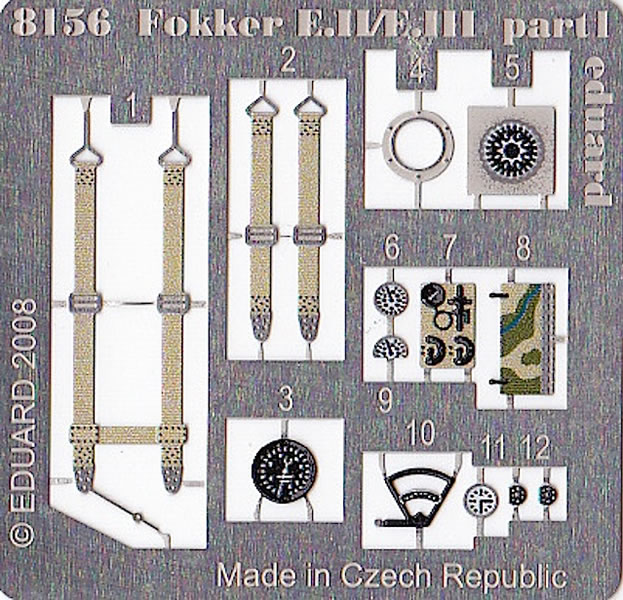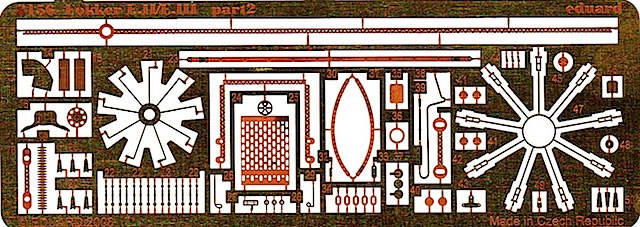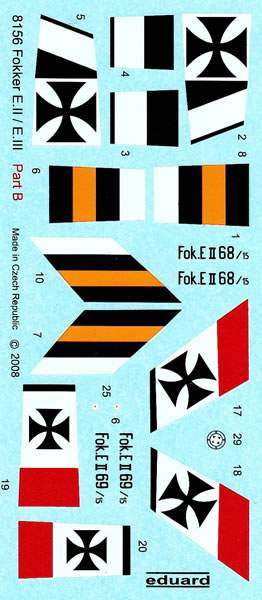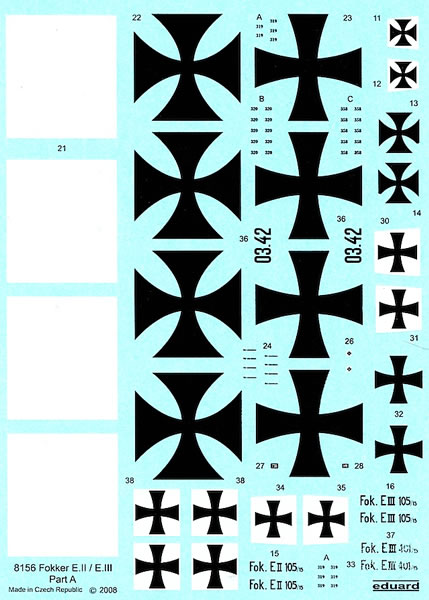|
Fokker E.II/E.III

Eduard ProfiPACK, 1/48 scale
S
u m m a r y |
| Catalogue Number: |
Eduard Kit No.8156 - Fokker E.II/E.III Profipack |
| Scale: |
1/48 |
| Contents and Media: |
Approximately 96 grey coloured plastic parts (3 unused); 1 clear plastic parts; 2 frets of photo-etched brass parts (1 painted, 1 unpainted); 1 sheet of die-cut tape masks; 2 decal sheets containing markings for 5 different aircraft; 12 page A5 full colour instruction booklet |
| Price: |
USD$34.95 plus shipping available online from Eduard’s website and specialist hobby retailers worldwide. |
| Review Type: |
FirstLook |
| Advantages: |
Generally accurate; highly detailed; large and interesting range of marking options. |
| Disadvantages: |
Some minor inaccuracies and build niggles. |
| Conclusion: |
Eduard’s new-ish tool Eindecker is by far the best 1/48 kit of this famous aircraft. It’s not perfect, but captures the essence of Fokker’s game-changing machine – highly recommended, and good to see re-released by Eduard. |
Reviewed by Brad Fallen

Eduard's 1/48 scale Spitfire Mk.VIII will be available online from Squadron.com
Antony Fokker’s Eindecker monoplane is one of the most famous aircraft of World War I. It wasn’t an outstanding design in its own right, and already obsolescent when deployed to the Western Front in mid-1915. But when fitted with a working interrupter gear – which allowed the pilot to aim and fire a fixed machine gun through the propeller arc – the Eindecker outclassed British and French machines with no such advantage. Allied responses such as the DH.2 pusher eroded the Fokker’s advantage and exposed its weaknesses, and within 18 months it had been phased out of service.
The Eindecker’s success as a modelling subject has been considerably longer. Top accolades are currently held by Wingnut Wings’ magnificent 1/32 series that includes the E.I, E.II/III (early and late versions) and E.IV. However these kits are relative newcomers, having all been released since 2012. Not so in 1/48 scale, where Eduard’s Eindecker kits have set the standard for more than 20 years. The company’s first E.III kit, released back in 1994, was essentially limited run but still built up into a good model. 14 years later Eduard followed up with a completely new tool kit, which eclipsed the earlier release and received universally positive reviews, including from Hyperscale’s Rob Baumgartner.
Eduard has since repackaged this kit several times, and in June 2015 reissued it in its original 2008 boxing.
This re-release seems almost identical to the kit reviewed by Rob seven years ago, from the box art of Ernst Udet’s E.II (marking option C) peeling away from a stricken Nieuport Bebe to the decals and photo-etched parts that are date-stamped ‘2008’.
Rob’s examination was very thorough and included a detailed assessment of contents and accuracy, a partial build of the kit and a description of the differences between the E.II and E.III variants. There isn’t much I can add to this so I will limit my comments to general observations.
The three coloured sprues are moulded in Eduard’s new grey rather than original olive brown plastic. The moulds remain in good condition with crisp detail everywhere and only a few wafers of flash to be seen. The larger parts incorporate some fine moulded details – the wings for example feature delicately raised rib tapes that with careful masking and painting will convincingly imitate the original, fragile structures. I also like how Eduard has moulded the bracing wires inside the fuselage halves, rather than providing them as photo-etched brass. I’ve found these wires challenging enough to replicate in 1/32 scale, so the moulded solution is a good one for 1/48. Less satisfying is Eduard’s representation of raised tapes on the fuselage exterior – as pointed out in Rob’s review – but this problem can be addressed with some careful sanding.
Smaller plastic parts are also well moulded, with the cockpit coaming, engine and optional cowlings particular highlights. The internal fuselage framework and undercarriage are thin, fragile parts that will demand care to remove and clean up without damage.
There is only one clear plastic part – a small windscreen with well defined framing for which Eduard supplies pre-cut masks to help with painting.
Eduard has been judicious in choosing which components to represent in photo-etch.

There aren’t an excessive number of brass parts – 12 pre-painted and 50 unpainted, although a number of the latter are supplied in duplicate. Most of the pre-painted parts are intended for the cockpit, while the unpainted brass will provide engine, machine gun and other exterior details.

Perhaps the most challenging photo-etched parts to use will be the long pieces of fuselage stitching and cowling strap, and (at the other end of the scale) the tiny rigging turnbuckles and anchor points that almost scream ‘lose me!’
Eduard’s instructions do a good job of presenting the somewhat complex construction process. The cockpit is especially busy and modellers will need to pay attention to get everything together in the right order and correctly aligned. There are also a number of optional parts used, and you will have to decide quite early on which of the marking options you are going to build. Gunze paint numbers are used to call out detailing colours throughout the build.
An entire page is devoted to rigging illustrations, but these aren’t as clear as they might be and my recommendation would be to open – or download – the instructions for Wingnut Wings E.II/III kits that include superb rigging guide.
Full colour, four view airframe drawings (and a front view of the engine cowling and propeller) are provided to assist with painting and decaling. Eindeckers aren’t the most colourful World War I aircraft, but their largely monotone finishes are a great canvas for weathering. The colour and tone of these finishes varied considerably, so I’d recommend checking references in relation to your chosen subject.
The two decal sheets have been produced by Eduard and are well done in terms of colour definition. I like how the white backgrounds to the wing crosses are supplied as separate parts, giving modellers the option to paint the backgrounds should they wish to do so. (This is something close to my heart at the moment as I struggle with the all-in-one black and white wing cross decals on Wingnut’s 1/32 Roland C.II.)
Markings
Markings are included for the following five Eindeckers (as per the original release):
-
Fokker E.II, 68/15, flown by Lt. Bruckman, late 1915.
-
Fokker E.II, 69/15, flown by Lt. Kurt von Crailsheim, late 1915.
-
Fokker E.II, serial unknown/not provided, flown by Vfw. Ernst Udet, early 1916.
-
Fokker E.III, serial unknown/not provided, flown by Leopold Anslinger, Summer 1916.
-
Fokker A.III 03.42, operated by Austro-Hungarian K.u,K. Luftfahrtruppen, 1915/16.


Decals are well printed and in perfect register.
If you want a 1/48 Fokker E.II or E.III, Eduard’s second-generation Eindecker is the best game in town. The kit’s not perfect, as Rob’s review attests, but it captures the essence of Fokker’s simultaneously primitive and complex machine. Good to see it re-released, and highly recommended.
Thanks to Eduard for the sample
Review Text Copyright © 2015 by
Brett Green
Page Created 30 November, 2015
Last updated
30 November, 2015
Back to HyperScale Main Page
Back to Reviews Page |
